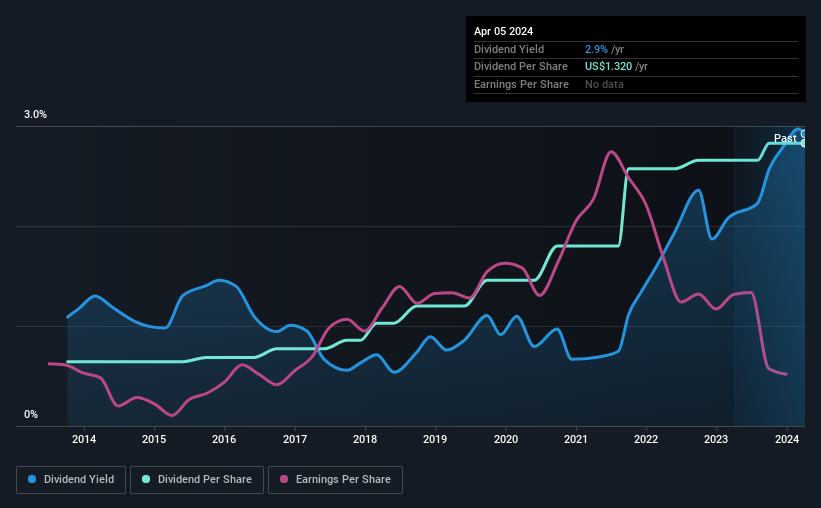Do These 3 Checks Before Buying Johnson Outdoors Inc. (NASDAQ:JOUT) For Its Upcoming Dividend
It looks like Johnson Outdoors Inc. (NASDAQ:JOUT) is about to go ex-dividend in the next 3 days. The ex-dividend date is usually set to be one business day before the record date which is the cut-off date on which you must be present on the company's books as a shareholder in order to receive the dividend. The ex-dividend date is important as the process of settlement involves two full business days. So if you miss that date, you would not show up on the company's books on the record date. This means that investors who purchase Johnson Outdoors' shares on or after the 10th of April will not receive the dividend, which will be paid on the 25th of April.
The company's upcoming dividend is US$0.33 a share, following on from the last 12 months, when the company distributed a total of US$1.32 per share to shareholders. Based on the last year's worth of payments, Johnson Outdoors stock has a trailing yield of around 2.9% on the current share price of US$45.16. Dividends are a major contributor to investment returns for long term holders, but only if the dividend continues to be paid. That's why we should always check whether the dividend payments appear sustainable, and if the company is growing.
Check out our latest analysis for Johnson Outdoors
Dividends are typically paid out of company income, so if a company pays out more than it earned, its dividend is usually at a higher risk of being cut. Johnson Outdoors paid out 74% of its earnings to investors last year, a normal payout level for most businesses. That said, even highly profitable companies sometimes might not generate enough cash to pay the dividend, which is why we should always check if the dividend is covered by cash flow. Over the last year, it paid out dividends equivalent to 279% of what it generated in free cash flow, a disturbingly high percentage. It's pretty hard to pay out more than you earn, so we wonder how Johnson Outdoors intends to continue funding this dividend, or if it could be forced to cut the payment.
Johnson Outdoors does have a large net cash position on the balance sheet, which could fund large dividends for a time, if the company so chose. Still, smart investors know that it is better to assess dividends relative to the cash and profit generated by the business. Paying dividends out of cash on the balance sheet is not long-term sustainable.
While Johnson Outdoors's dividends were covered by the company's reported profits, cash is somewhat more important, so it's not great to see that the company didn't generate enough cash to pay its dividend. Were this to happen repeatedly, this would be a risk to Johnson Outdoors's ability to maintain its dividend.
Click here to see how much of its profit Johnson Outdoors paid out over the last 12 months.
Have Earnings And Dividends Been Growing?
Businesses with shrinking earnings are tricky from a dividend perspective. Investors love dividends, so if earnings fall and the dividend is reduced, expect a stock to be sold off heavily at the same time. Readers will understand then, why we're concerned to see Johnson Outdoors's earnings per share have dropped 16% a year over the past five years. Ultimately, when earnings per share decline, the size of the pie from which dividends can be paid, shrinks.
The main way most investors will assess a company's dividend prospects is by checking the historical rate of dividend growth. In the last 10 years, Johnson Outdoors has lifted its dividend by approximately 16% a year on average. Growing the dividend payout ratio while earnings are declining can deliver nice returns for a while, but it's always worth checking for when the company can't increase the payout ratio any more - because then the music stops.
Final Takeaway
From a dividend perspective, should investors buy or avoid Johnson Outdoors? It's definitely not great to see earnings per share shrinking. The company paid out an acceptable percentage of its income, but an uncomfortably high percentage of its cash flow over the past year. With the way things are shaping up from a dividend perspective, we'd be inclined to steer clear of Johnson Outdoors.
So if you're still interested in Johnson Outdoors despite it's poor dividend qualities, you should be well informed on some of the risks facing this stock. To help with this, we've discovered 2 warning signs for Johnson Outdoors that you should be aware of before investing in their shares.
A common investing mistake is buying the first interesting stock you see. Here you can find a full list of high-yield dividend stocks.
Have feedback on this article? Concerned about the content? Get in touch with us directly. Alternatively, email editorial-team (at) simplywallst.com.
This article by Simply Wall St is general in nature. We provide commentary based on historical data and analyst forecasts only using an unbiased methodology and our articles are not intended to be financial advice. It does not constitute a recommendation to buy or sell any stock, and does not take account of your objectives, or your financial situation. We aim to bring you long-term focused analysis driven by fundamental data. Note that our analysis may not factor in the latest price-sensitive company announcements or qualitative material. Simply Wall St has no position in any stocks mentioned.

 Yahoo Finance
Yahoo Finance 
